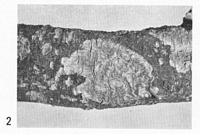|
![Go to the NZFungi website for more indepth information on Phlebia sp. [2].](../images/nzfungi_icon_ani.gif) Phlebia sp. [2] Phlebia sp. [2]
SynonymsCorticium vitellinum
BiostatusPresent in region - Indigenous. Non endemic
Images (click to enlarge)
Caption: PLATE 13, FIG. 2. Corticium vitellinum. x 1. |
Article: Cunningham, G.H. (1954). Thelephoraceae of New Zealand. Part III: the genus Corticium. Transactions of the Royal Society of New Zealand 82(2): 271-327.
Description: Hymenophore annual, loosely attached, membranous-ceraceous. pelliculose, effused, forming
many irregularly orbicular colonies 0.5-5 cm. diameter, or linear areas to 16 x 2 cm.; surface
at first egg-yolk yellow, becoming reddish-brown in the centre with yellow periphery,
vernicose, finally scantily creviced; margin thinning out, tending to lift, at first white,
becoming yellow, byssoid, vernicose. Context white, 300-800 µ thick, commonly 300-400 µ,
composed of a narrow basal layer of compact parallel hyphae, an intermediate layer of woven
hyphae embedded in crystals, occupying the greater part of the context, and a subhymenium
of densely compacted, closely septate, often obliquely arranged hyphae coated with mucilage
granules which extend to the tissues of the hymenium; generative hyphae 2.5-3 µ diameter,
wall 0.2 µ thick, naked, hyaline, branched, septate, with abundant clamp connections.
Hymenial layer to 40 µ deep, of basidia and paraphyses. Basidia subclavate, 16-24 x 5-6 µ, 2-4-spored; sterigmata slender, to 6 µ long.
Paraphyses subclavate, narrower than the basidia.
Spores elliptical, 4-5.5 x 2-2.5 µ, wall smooth, hyaline, 0.2 µ thick.
Habitat: HABITAT. Effused on bark of dead standing saplings and stems.
Distribution: DISTRIBUTION. New Zealand.
Notes: In size and shape of spores and basidia the species resembles C. leptospermi; it differs in
context structure, surface features and absence of paraphysate hyphae. Context tissues are
arranged in three distinct zones: a basal narrow layer of compact mainly parallel hyphae, an
intermediate layer of woven (not vertical) hyphae, and a narrow, compact subhymenium, cells
of which are cubical and cemented together. Masses of crystals are packed between hyphae of
the intermediate layer, and additionally granules of mucilage coat hyphae and basidia in the
collection from Rubus. In young plants the surface is bright egg-yolk yellow, smooth and
varnished; as specimens age the centre turns reddish-brown though still retaining its polished
appearance, and finally deep fissures appear, though somewhat sparingly.
Article: Stalpers, J.A. (1985). Type studies of the species of Corticium described by G.H. Cunningham. New Zealand Journal of Botany 23(2): 301-310 (http://www.rsnz.org/publish/abstracts.php).
Description: = Phlebia sp.
Hymenial surface even to warted. Subicular hyphae hyaline, thin- to slightly thick-walled,
2.5-4 µm wide, with clamps at all septa. Hyphae not agglutinated except in the subhymenium.
Crystalline material abundant on and between the hyphae. Cystidia absent. Basidia subclavate
to subcylindrical, 15-22 X 3.5-5 µm. Spores hyaline, thin-walled, ellipsoid to cylindrical, 5-6.5 X 2.5-3 µm (few seen). Resinous material present between the basidia.
Notes: The species belongs to Phlebia and is close to or identical with Ph. nitidula (P. Karst.) Ryv.
|